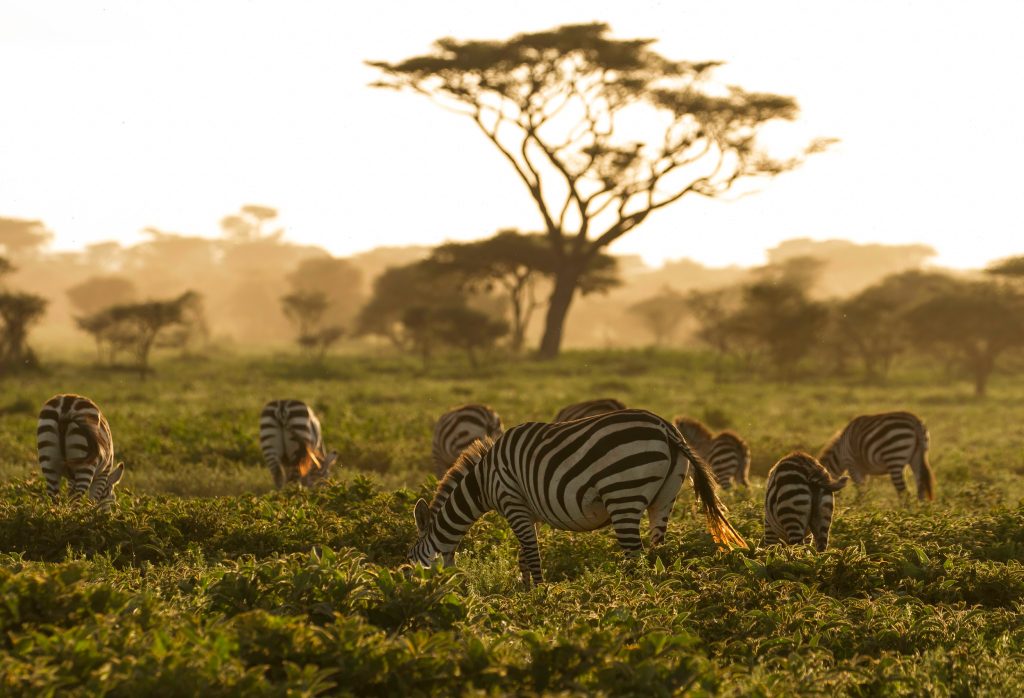
The great wildebeest migration is a must-see for wildlife enthusiasts. You’ll spend four days in the park witnessing the highlights of this spectacular event. You will observe millions of antelopes and zebras making their journey from Tanzania to Kenya in search of green pastures. You’ll witness the thrilling moments when lions and leopards take advantage of the migration for their own hunting pursuits.
You’ll take a flight from ZNZ Airport to Kogatende Airstrip between 8:00 – 11:00 am (departure times subject to seat availability).
Upon arrival at Kogatende (KOG), a friendly English-speaking guide will welcome you, and each guest will receive a gift of champagne and fruits.
The safari adventure kicks off right after leaving the airstrip. You’ll explore the Serengeti, Tanzania’s jewel, and witness one of the world’s most spectacular shows — the Great Migration. Millions of wildebeests, zebras, and antelopes embark on a massive journey in search of water and food, crossing the Mara River into the Kenyan side, Masai Mara.
The river is teeming with crocodiles, offering a thrilling opportunity to witness these predators in action if you’re fortunate enough.
You will begin your day with a memorable sunrise safari. Our safari kicks off bright and early at 6:00 am to catch the vibrant activity of the animals, as they are most active during these early hours.
By around 9:00 in the morning, you’ll head back to the hotel where you can enjoy a hearty breakfast, take some time to rest, and then venture out once more in pursuit of thrilling adventures.
After breakfast, you will embark on a safari game drive in Serengeti National Park, exploring the vast plains in search of both large predators and gentle herbivores. Later in the afternoon, you’ll head to Ngorongoro Conservation Area. In the evening, you will enjoy dinner and spend the night at Ngorongoro Marera Mountain View Lodge on a full-board basis.
After a delightful breakfast, you’ll grab your picnic lunches and embark on a visit to one of the Seven African Wonders, the Ngorongoro Crater. This natural marvel was formed two million years ago during a massive volcanic eruption, creating a fertile lava landscape and a unique ecosystem.
Known for having the highest concentration of animals in Africa, the crater is home to numerous lion families, buffalos, zebras, wildebeests, and various other species. It provides an exceptional opportunity to spot the rare black rhinos.
Following a rewarding day in the Ngorongoro Crater, your driver guide will transfer you to Arusha Airport to catch your flight to Zanzibar.

Dry Season: June to October
Pleasant temperatures, sunny skies, and little rain.
Best for wildlife viewing — animals gather around rivers and waterholes.
Short Rain Season: November to December
Brief showers, mainly in the afternoons — still good for safari.
Long Rain Season: March to May
Heavy rains; some lodges close due to muddy roads and reduced accessibility.
Fewer tourists and lower prices.
High Season (more tourists): June to October & December to February
Perfect weather and peak wildlife visibility.
Low Season (fewer tourists): March to May
Rainy season — ideal for budget travelers and photographers who love green landscapes.
January to February: In the Southern Serengeti (Ndutu area) —
Thousands of wildebeest give birth.
Excellent time to see predator action (cheetahs, lions, hyenas).
December to April: Southern Serengeti (Ndutu area) — calving season.
May to June: Central Serengeti — herds move north.
July to September: Northern Serengeti & Masai Mara — river crossings at the Grumeti and Mara Rivers.
October to November: Return southward to the Serengeti.
Passport + copies
Travel insurance documents
First-aid kit: antiseptic, painkillers, anti-diarrheal meds, band-aids, motion sickness tablets, mosquito repellent
Prescription medication (in original packaging)
Sun protection: sunscreen (SPF 30+), hat, sunglasses
Camera + extra batteries/memory cards
Binoculars
Reusable water bottle
Small backpack for daily game drives
Lightweight flashlight/headlamp
Universal power adapter
Neutral colors: khaki, beige, olive, brown (avoid bright colors and dark blue/black — attract insects).
Lightweight, breathable long sleeves and trousers for sun and insect protection.
Light jacket or fleece for cool mornings and evenings.
Comfortable closed shoes or hiking boots.
Hat with wide brim.
Swimsuit if your lodge has a pool.
Respect local culture: modest clothing (avoid short shorts or low tops).
Light, casual clothing for warm weather.
A light sweater or jacket for evenings.
Currency: Tanzanian Shilling (TZS).
You can withdraw cash using ATMs in major towns (Arusha, Moshi, Dar es Salaam).
Best banks: CRDB, NBC, NMB.
Use Visa cards — Mastercard may not always work.
Minimize fees:
Withdraw larger amounts at once (max ~400,000–1,000,000 TZS per transaction).
Use ATMs with low international charges (check with your bank).
USD is widely accepted for hotels and park fees — bring clean, post-2009 bills.
Lodges and camps provide full-board or half-board (breakfast, lunch, dinner).
Expect a mix of continental and local dishes:
Rice, beans, ugali (maize porridge), grilled meats, vegetables, tropical fruits.
Vegetarians and special diets are well accommodated (inform your operator in advance).
Bottled or filtered water is always recommended.
Lodges and camps provide full-board or half-board (breakfast, lunch, dinner).
Expect a mix of continental and local dishes:
Rice, beans, ugali (maize porridge), grilled meats, vegetables, tropical fruits.
Vegetarians and special diets are well accommodated (inform your operator in advance).
Bottled or filtered water is always recommended.
Most safari companies and lodges accept:
Bank transfer (SWIFT)
Credit/debit card (Visa/Mastercard; 3–5% surcharge)
Cash in USD (for tips or local payments)
Always confirm the payment method and currency before sending money.
Avoid sending money through unofficial links or unverified accounts.

© 2023 all right with tanzania with keny